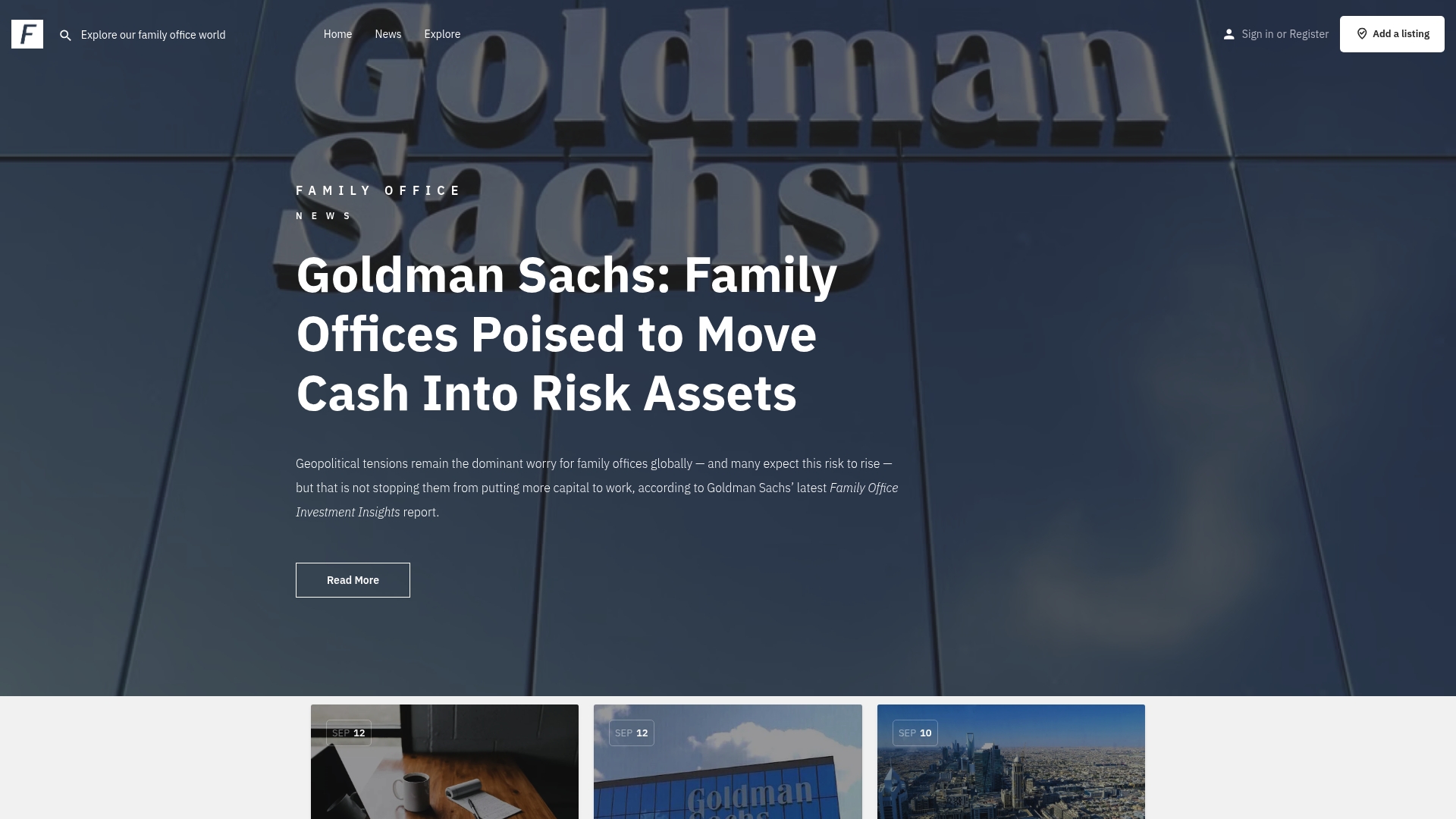Did you know that only about one third of family offices have formal plans for leadership transitions? With billions at stake, failing to identify and manage risks exposes family wealth to unexpected threats. From digital attacks to shifting markets, the challenges facing today’s family offices are more diverse than ever. Understanding the most critical risks and building a tailored protection strategy puts you one step ahead and helps safeguard your legacy for generations.
Table of Contents
- Understand Key Risk Types Facing Family Offices
- Develop a Customized Risk Assessment Framework
- Implement Strong Internal Controls and Policies
- Prioritize Cybersecurity and Data Protection
- Establish Clear Succession and Continuity Plans
- Enhance Vendor and Third-Party Due Diligence
- Regularly Review and Update Risk Protocols
Quick Summary
| Takeaway | Explanation |
|---|---|
| 1. Identify key risk types early | Understand cyber threats, financial uncertainties, reputational challenges, and operational vulnerabilities to proactively manage risks. |
| 2. Develop a tailored risk assessment framework | Create a flexible framework that evaluates financial, operational, and external risks specific to your family office’s needs. |
| 3. Implement strong internal controls | Establish clear policies and processes to safeguard financial assets and ensure organizational integrity through effective oversight. |
| 4. Prioritize cybersecurity measures | Develop a comprehensive strategy that includes threat detection, data encryption, and regular audits to protect sensitive information. |
| 5. Regularly review risk protocols | Continually assess and update risk management strategies to adapt to new threats and changes in the financial landscape. |
1. Understand Key Risk Types Facing Family Offices
Navigating the complex world of family office management requires a strategic approach to risk identification and mitigation. According to research from Columbia University, family offices are exposed to a multifaceted landscape of potential challenges that demand careful attention and proactive management.
Risk Spectrum in Family Offices
The risk environment for family offices is broad and dynamic, encompassing several critical domains that can impact financial stability and operational effectiveness. Based on comprehensive research, key risk categories include:
- Cyber Threats: Digital vulnerabilities that can compromise sensitive financial and personal information
- Financial Uncertainties: Market fluctuations and investment performance risks
- Reputational Challenges: Potential damage to family legacy and professional standing
- Operational Vulnerabilities: Internal processes and governance weaknesses
Research from the CFA Institute highlights specific market risks, particularly in emerging and volatile sectors like blockchain, electric vehicles, and cannabis industries. These sectors are prone to significant valuation bubbles and intense regulatory scrutiny, presenting unique investment challenges for family offices.
To effectively manage these risks, you need a comprehensive and nuanced approach. Start by conducting a thorough risk assessment that maps out potential vulnerabilities across financial, technological, legal, and operational domains. Develop robust monitoring systems that can detect early warning signals and create flexible response strategies.
Implement a dynamic risk management framework that allows for continuous evaluation and adaptation. This means regularly reviewing your investment portfolios, updating cybersecurity protocols, and maintaining transparent communication channels within your family office ecosystem.
Remember that understanding risk is not about elimination but strategic navigation. By developing a proactive and holistic risk management approach, you can transform potential threats into opportunities for growth and resilience.
2. Develop a Customized Risk Assessment Framework
Building a robust risk assessment framework is not a one size fits all solution for family offices. It requires a strategic and personalized approach that reflects your unique financial landscape and organizational complexity.
According to research from Columbia University, family offices must establish structured processes to systematically identify, assess, and mitigate potential risks. This proactive approach ensures preparedness for unexpected disruptions like economic downturns or sudden market shifts.
Framework Development Essentials
A comprehensive risk assessment framework should encompass multiple critical dimensions:
- Financial Risk Evaluation: Analyzing investment portfolio vulnerabilities
- Operational Risk Management: Identifying internal process weaknesses
- External Environment Scanning: Monitoring regulatory and market changes
- Scenario Planning: Developing responsive strategies for potential disruptions
Research from the Alternative Investment Management Association emphasizes that modern family offices must continuously modernize operations to achieve greater efficiency and maintain robust internal control mechanisms.
To create an effective framework, you need a systematic approach. Start by mapping out all potential risk domains specific to your family office. This means conducting thorough internal assessments that go beyond traditional financial metrics and include technological, reputational, and strategic risk dimensions.
Implement a dynamic risk scoring system that allows for regular updates and recalibration. This might involve quarterly review sessions where key stakeholders evaluate emerging risks and adjust mitigation strategies accordingly. Utilize advanced analytics and predictive modeling tools to enhance your risk assessment capabilities.
Remember that a risk assessment framework is not a static document but a living strategy. Regular refinement and adaptability are crucial to staying ahead of potential challenges and protecting your family office’s long term interests.
By developing a nuanced and flexible risk assessment approach, you transform potential vulnerabilities into strategic opportunities for growth and resilience.
3. Implement Strong Internal Controls and Policies
Establishing robust internal controls and policies is the cornerstone of effective risk management for family offices. These structured guidelines create a protective framework that safeguards your financial assets and operational integrity.
According to research from the Alternative Investment Management Association, family offices must modernize their operations to achieve greater efficiency and maintain stringent internal cost controls while delivering high quality services.
Critical Components of Internal Control Systems
A comprehensive internal control strategy should address multiple key areas:
- Financial Oversight: Implementing rigorous financial reporting and approval processes
- Authorization Protocols: Creating clear decision making hierarchies
- Segregation of Duties: Preventing potential conflicts of interest
- Compliance Monitoring: Tracking regulatory and legal requirements
Research from Columbia University emphasizes that structured processes are crucial for identifying, assessing, and mitigating potential risks. This approach ensures your family office remains prepared for unexpected disruptions.
To develop effective internal controls, start by conducting a thorough audit of your current operational processes. Map out all potential points of vulnerability and design specific policies that address each risk area. This might include detailed protocols for investment approvals, expense management, and technology access.
Consider implementing a four eyes principle where significant financial transactions require approval from two separate authorized individuals. This simple yet powerful control mechanism can dramatically reduce the risk of unauthorized or fraudulent activities.
Regular training programs are essential to ensure all team members understand and adhere to established policies. Create a culture of accountability where everyone recognizes their role in maintaining organizational integrity.
Remember that internal controls are not about restricting operations but creating a secure environment where your family office can operate with confidence and transparency. By investing time in developing comprehensive policies, you protect your financial legacy and create a foundation for sustainable growth.
4. Prioritize Cybersecurity and Data Protection
In an era of increasing digital threats, cybersecurity has become a critical lifeline for family offices managing substantial financial assets and sensitive personal information. Protecting your digital ecosystem is no longer optional it is an absolute necessity.
According to research from Cyber Insurance News, many family offices recognize cybersecurity as a top organizational risk yet frequently lack robust incident response plans and advanced defensive strategies. This vulnerability exposes them to significant potential financial and reputational damage.
Comprehensive Cybersecurity Strategy
A proactive approach to digital protection requires multifaceted defensive mechanisms:
- Advanced Threat Detection: Implementing sophisticated monitoring systems
- Data Encryption: Protecting confidential information across all platforms
- Regular Security Audits: Identifying and addressing potential vulnerabilities
- Employee Training: Creating a culture of cybersecurity awareness
The Alternative Investment Management Association emphasizes that family offices must protect clients confidential information by implementing adequate security controls to guard against existing and emerging cyber threats.
To develop a robust cybersecurity framework, start by conducting a comprehensive digital risk assessment. Map out all potential entry points for cyber attacks and create layered defense strategies. This includes implementing multifactor authentication, using secure cloud storage with end to end encryption, and establishing strict access protocols.
Invest in continuous employee education. Cybersecurity is not just a technology issue but a human one. Regular training sessions that simulate phishing attempts and discuss emerging threat landscapes can transform your team into a proactive defense mechanism.
Consider engaging specialized cybersecurity consultants who understand the unique challenges faced by family offices. They can provide tailored solutions that go beyond generic protective measures.
Remember that cybersecurity is an ongoing process, not a one time implementation. Stay vigilant, adapt quickly, and view digital protection as a critical investment in your family offices long term stability and reputation.
5. Establish Clear Succession and Continuity Plans
Succession planning represents the critical bridge between your family office’s current success and its long term sustainability. Without a strategic roadmap for leadership transition, even the most sophisticated financial operations can quickly unravel.
Research from the Wharton School reveals a startling reality only one third of family offices have formal or informal plans for ownership, management, and control transitions. This governance gap poses significant risks to generational wealth preservation.
Key Elements of Effective Succession Planning
A comprehensive succession strategy must address multiple interconnected dimensions:
- Leadership Development: Identifying and grooming potential future leaders
- Knowledge Transfer: Creating systematic processes for institutional memory preservation
- Role Definition: Clarifying responsibilities and decision making authorities
- Skill Assessment: Evaluating next generation capabilities objectively
According to the Alternative Investment Management Association, generational transition remains a top concern for family offices. Fewer than one third have a formal succession plan highlighting the urgent need for proactive strategy development.
To build an effective succession framework, start by facilitating open conversations across generations. This means creating structured dialogue opportunities where senior leadership can understand the aspirations, skills, and perspectives of younger family members.
Implement a mentorship and training program that gradually introduces next generation members to complex family office operations. This approach allows for organic skill development and provides realistic exposure to the intricacies of wealth management.
Consider engaging external advisors who specialize in family office governance. Their objective perspective can help navigate potential emotional complexities and design a transition strategy that balances family dynamics with professional requirements.
Remember that successful succession planning is not about enforcing a predetermined path but creating a flexible framework that empowers future leaders while preserving the core values and vision of your family office.
6. Enhance Vendor and Third-Party Due Diligence
In the interconnected world of family office operations, your network of vendors and third party providers can be either your greatest strength or your most significant vulnerability. Comprehensive due diligence is not just a recommended practice it is a critical risk management strategy.
According to a Cyber Insurance News report, many family offices lack robust ‘know your vendor’ protocols, significantly increasing their exposure to potential cyber threats and operational risks.
Strategic Vendor Risk Management
A comprehensive third party assessment should encompass multiple critical evaluation dimensions:
-
Financial Stability: Analyzing vendor financial health and sustainability
-
Cybersecurity Capabilities: Assessing vendor digital security infrastructure
-
Compliance Track Record: Reviewing regulatory and legal adherence history
-
Operational Reputation: Investigating past performance and client references
Research from Columbia University emphasizes the importance of establishing structured processes to identify, assess, and mitigate risks associated with external partners and service providers.
To implement effective vendor due diligence, develop a standardized evaluation framework that goes beyond surface level assessments. This means creating a comprehensive scoring system that objectively measures potential risks across multiple dimensions.
Consider implementing a tiered vendor assessment approach where critical vendors undergo more rigorous and frequent evaluations. Develop detailed questionnaires that probe deep into their operational practices, technological capabilities, and risk management strategies.
Regularly conduct surprise audits and request updated documentation from your vendors. Maintain an active monitoring system that tracks changes in their operational landscape, financial status, and potential risk indicators.
Remember that vendor due diligence is an ongoing process, not a one time checkpoint. By treating your vendor relationships as strategic partnerships and maintaining continuous vigilance, you create a robust protective layer around your family office’s operational ecosystem.
7. Regularly Review and Update Risk Protocols
Risk management is not a static process but a dynamic journey of continuous adaptation and improvement. Your family office’s risk protocols must evolve as quickly as the complex financial landscape transforms around you.
According to research from Columbia University, family offices should proactively review and update risk protocols to ensure preparedness for unexpected disruptions such as economic downturns or systemic market shifts.
Comprehensive Protocol Review Strategy
An effective risk protocol review should encompass multiple strategic dimensions:
- Quarterly Performance Assessments: Analyzing existing risk mitigation strategies
- Emerging Threat Monitoring: Tracking new potential vulnerabilities
- Technological Infrastructure Evaluation: Assessing current defensive capabilities
- Regulatory Compliance Verification: Ensuring alignment with latest industry standards
The Alternative Investment Management Association emphasizes that modernizing operations can help family offices achieve greater efficiency while maintaining robust risk control mechanisms.
To implement a dynamic review process, establish a structured protocol review calendar. Schedule comprehensive assessments at least quarterly, with additional interim evaluations triggered by significant market events or internal organizational changes.
Create a cross functional risk review team that includes representatives from different operational areas. This approach ensures a holistic perspective that captures nuanced insights from multiple organizational vantage points.
Utilize advanced analytics and predictive modeling tools to simulate potential risk scenarios. These technologies can help you anticipate and prepare for emerging challenges before they materialize.
Remember that risk protocol review is not about creating perfect defenses but building adaptive systems that can quickly respond and recalibrate. Your goal is developing organizational resilience that transforms potential vulnerabilities into strategic opportunities for growth and protection.
Below is a comprehensive table summarizing the key risks, strategies, and management practices for family offices discussed throughout the article.
| Topic | Description | Key Considerations |
|---|---|---|
| Risk Types | Family offices face cyber threats, financial uncertainties, reputational challenges, and operational vulnerabilities. | Conduct thorough risk assessments and develop flexible response strategies. |
| Risk Assessment Framework | A personalized risk assessment framework addresses financial, operational, and external risks. | Use advanced analytics and regularly update risk scoring systems. |
| Internal Controls | Implement robust policies for financial oversight, authorization protocols, and compliance monitoring. | Conduct internal audits and establish the four eyes principle for transactions. |
| Cybersecurity | Develop a comprehensive strategy including threat detection and data encryption. | Provide regular employee training and engage cybersecurity consultants. |
| Succession Planning | Ensure a strategic roadmap for leadership transition and generational wealth preservation. | Facilitate open dialogue and mentorship programs across generations. |
| Vendor Due Diligence | Evaluate vendor financial stability, cybersecurity capabilities, and compliance records. | Develop a tiered assessment approach and conduct surprise audits. |
| Review and Update Protocols | Regularly review risk protocols to adapt to new financial landscapes. | Establish a review calendar and utilize predictive modeling tools. |
Strengthen Your Family Office Risk Management Today
Managing the intricate risks facing family offices requires more than just awareness it demands a proactive, tailored strategy. If you want to protect your financial legacy from cyber threats, operational vulnerabilities, or generational transitions the insights shared in “7 Essential Family Office Risk Management Tips Explained” highlight the urgency of building strong internal controls and customizing your frameworks.
Take decisive action now by connecting with a global community of experts and service providers who understand your unique challenges. Explore trusted resources and discover solutions designed specifically for ultra-high-net-worth investors on Future Family Office.

Join fellow family offices and industry professionals on Future Family Office to access the latest risk management tools, expert guidance, and networking opportunities. Don’t wait for risks to become realities visit our platform today and empower your family office with confidence and resilience.
Frequently Asked Questions
What are the key risk types that family offices should focus on?
Family offices should focus on cyber threats, financial uncertainties, reputational challenges, and operational vulnerabilities. Begin by conducting a comprehensive risk assessment that identifies these categories within your organizational environment.
How can I develop a customized risk assessment framework for my family office?
To develop a customized risk assessment framework, identify potential risk domains specific to your operations. Map these out and create a dynamic risk scoring system that is revisited quarterly to adapt to any emerging threats.
What essential internal controls should a family office implement?
Essential internal controls include financial oversight, clear authorization protocols, segregation of duties, and compliance monitoring. Start with a thorough internal process audit to identify vulnerable points and establish tailored policies to address each area.
How can family offices enhance their cybersecurity and data protection strategies?
Family offices can enhance cybersecurity by implementing advanced threat detection, data encryption, and regular security audits. Take action by conducting a comprehensive digital risk assessment and establish multilayered defense strategies immediately.
What are the best practices for vendor and third-party due diligence?
Best practices for vendor due diligence include assessing financial stability, cybersecurity capabilities, and compliance track records. Develop a standardized evaluation framework that includes detailed questionnaires to thoroughly vet potential partners before engaging their services.
Why is regular review of risk protocols important for family offices?
Regular review of risk protocols is crucial as it allows family offices to adapt to changing financial landscapes and emerging threats. Establish a regular review schedule, aiming for at least quarterly evaluations to ensure ongoing preparedness and resilience.




